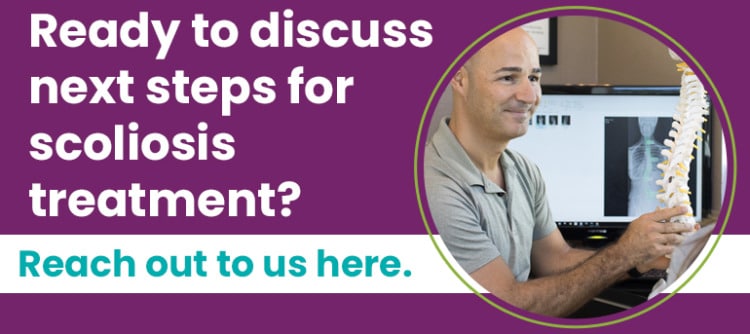When to Check for Scoliosis: Key Ages and Signs
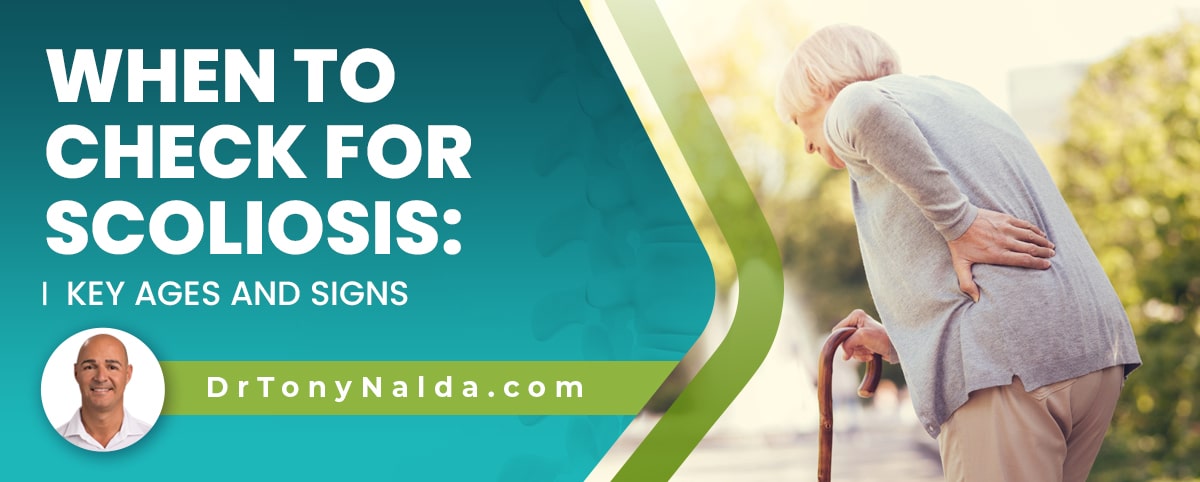
Scoliosis affects all ages, but is most commonly diagnosed in children. As a progressive spinal condition triggered by growth, it's important to check for signs of scoliosis before, during, and after growth. The earlier screening programs are started, the more potential there is for early detection; there is a direct link between early detection, early intervention, and treatment success.
As scoliosis is the leading spinal condition among school-aged children, it's important that children are regularly screened for signs of scoliosis. If risk factors are in place such as age, gender, and a family history, screening programs should be implemented early.
While some schools still conduct scoliosis screening exams, in many cases, it's up to parents, caregivers, and patients themselves to recognize the condition's early signs.
Table of Contents
What is Early Detection?
Scoliosis causes the spine to bend and twist unnaturally, and as a progressive condition, its nature is to get more severe over time.
Scoliosis progression means the size and rotation of the unnatural spinal curvature is increasing, as are the condition's effects, and the condition is becoming more complex to treat.
As scoliosis progresses, the spine becomes increasingly rigid, making it less responsive to treatment; this is why it's ideal to diagnose scoliosis while mild and start treatment immediately.
Scoliosis ranges widely in severity from mild scoliosis to moderate scoliosis, severe and very severe scoliosis.
The more severe a condition, the more complex it is to treat, so the goal of a proactive treatment approach is to prevent progression by addressing conditions while they are still mild.
Mild scoliosis means smaller curves; these are simpler to correct.
There are no treatment guarantees, but with most progressive conditions, it's more effective to work towards preventing progression and increasing effects than it is to attempt to reverse changes once they've occurred.
As scoliosis progresses, the main symptoms in children involve postural changes, and in adults, it's pain bringing them in for assessment, diagnosis, and treatment.
Signs of Scoliosis in Children
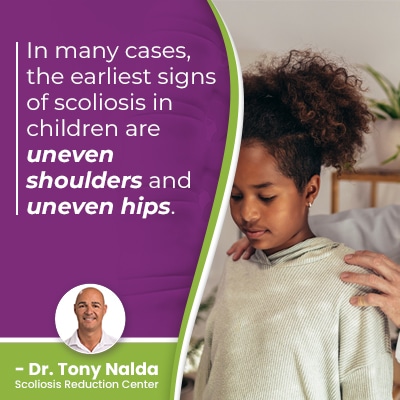 Scoliosis introduces a lot of uneven forces to the spine, its surroundings, and the entire body.
Scoliosis introduces a lot of uneven forces to the spine, its surroundings, and the entire body.
The condition's uneven forces disrupt the body's overall symmetry, and in children, as a child grows and the condition progresses, postural changes can become more noticeable.
In many cases, the earliest signs of scoliosis in children are uneven shoulders and uneven hips.
Additional postural changes to watch for include:
- Head appearing uncentered over the torso
- Uneven eye line
- Uneven shoulder blades (one shoulder blade protruding more on one side)
- Development of a rib cage arch
- Arms and legs hanging at different lengths
Postural changes caused by scoliosis will get worse over time, becoming more noticeable; mild changes can be difficult to notice, particularly in adolescents who aren't known for their good posture and/or transparency with sharing bodily changes.
As scoliosis progresses, disruptions to movement will also occur, so look out for changes in balance, coordination, and gait.
All ages are affected by scoliosis, but the most prevalent condition type overall is adolescent idiopathic scoliosis, and adolescents are also the most at risk for rapid-phase progression due to the stage of growth they are in.
Key Ages for Scoliosis Screening
When it comes to progressive conditions like scoliosis, the sooner treatment is started, the better. It's far more effective to proactively work towards preventing progression and increasing effects than it is to attempt to reverse condition effects once they're established.
The goal is to diagnose scoliosis early in the condition's progressive line so treatment can be started before significant progression has already occurred.
The goal of screening is to detect indicators of scoliosis that warrant further testing in the form of a scoliosis X-ray; an X-ray is needed to confirm the condition's rotational component and determine the patient's Cobb angle measurement.
A minimum Cobb angle of 10 degrees is needed to reach a diagnosis of scoliosis.
Adolescent idiopathic scoliosis is diagnosed between the ages of 10 and reaching skeletal maturity, and as scoliosis progression is triggered by growth, adolescents are the most at risk for fast and continued progression because of the rapid and unpredictable growth spurts of puberty.
So for children approaching adolescence, this is a good time to start checking for signs of scoliosis because there are many benefits associated with starting treatment prior to the first significant pubescent growth spurt.
And for children with known risk factors, screening should be started earlier and regularly during routine check ups.
Risk Factors
If certain risk factors are in place, screening programs need to be started earlier because the likelihood of developing scoliosis is higher.
Age, gender, and a family history are considered scoliosis risk factors.
Age is important as growth triggers progression, so children approaching puberty should be regularly screened. Females are more likely to be diagnosed and more likely to progress faster, and this is thought to be caused by the earlier onset of puberty in girls than boys. If another member of the family has already been diagnosed with scoliosis, regular screening should also be conducted.
Adolescents are most often diagnosed with scoliosis between 10 and 15 years of age, and as adolescent scoliosis is the most common type, this is the age group that should be monitored the closest for condition indicators and progression.
Although scoliosis isn't a genetic condition, it is considered to be familial, which is why a family history is considered a risk factor and warrants early screening.
Idiopathic scoliosis has no known cause, but we know how it progresses and how to manage it effectively, and additional types of scoliosis include neuromuscular scoliosis, degenerative scoliosis, and congenital scoliosis.
So children meeting any of the aforementioned risk factors should be regularly screened during routine physical examinations from a young age.
While there are no treatment guarantees, early detection and intervention are associated with treatment success.
Signs of Adult Scoliosis
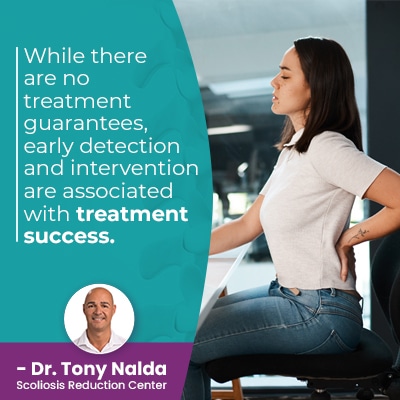 The main sign of adult scoliosis is pain.
The main sign of adult scoliosis is pain.
Scoliosis doesn't become a compressive condition until skeletal maturity has been reached, and compression is the main cause of condition-related pain.
Compression is uneven pressure, and it's compression of the spine and its surrounding muscles and nerves that brings most adults in for a diagnosis and treatment.
Compressive scoliosis pain can involve the muscles, the spine, and radiating pain into the extremities due to nerve compression.
Pain in the hands and feet is a common symptom of adult scoliosis.
While adults also experience postural changes and a noticeable lean to one side, it's pain that is the main symptom and brings most adults in to see me.
The most common type of scoliosis in adults is idiopathic scoliosis, and these cases highlight the importance of early detection because they involve adolescents who were neither diagnosed nor treated during adolescence; these conditions progress with time and growth and aren't diagnosed until skeletal maturity is reached, conditions become compressive, painful, and noticeable enough to lead to a diagnosis.
After idiopathic scoliosis, degenerative scoliosis is the most common in adults, and this type is caused by natural age-related spinal degeneration; it's most common in adults over the age of 45, and it's also more common in females than males.
Degenerative scoliosis can be particularly painful as the spine becomes increasingly unbalanced and unstable.
So signs of scoliosis in adults include pain, postural changes, and disruptions to movement, and these signs become more noticeable as the condition progresses.
Conclusion
Scoliosis affects every age from babies born with congenital scoliosis to infantile scoliosis, juvenile scoliosis, adolescent idiopathic scoliosis, and adult scoliosis is diagnosed once skeletal maturity has been reached.
If there is a family history of scoliosis, children should be regularly screened as part of routine check ups; as periods of intense growth are approaching, like puberty, more frequent screening tests should be performed.
Diagnosing scoliosis early means the opportunity to start treatment early is available, and for those who commit to a proactive non-surgical treatment approach, there are a number of benefits to diagnosing and addressing scoliosis while mild.
Mild scoliosis curves are smaller and easier to correct; as scoliosis progresses, the spine becomes increasingly rigid and less responsive to treatment.
While traditional scoliosis treatment commonly ends in spinal fusion surgery, conservative non-surgical treatment options have the goal of preventing progression and the need for surgical treatment.
Diagnosing scoliosis involves a physical exam, an adam's forward bend test, and X-ray results, and once scoliosis is diagnosed, the most important decision is how to treat the condition moving forward.
When scoliosis is diagnosed early and treated proactively, it can be highly responsive and treatable.
Here at the Scoliosis Reduction Center®, patients benefit from an innovative and integrative approach that combines the power of multiple scoliosis-specific treatment disciplines.
Dr. Tony Nalda
DOCTOR OF CHIROPRACTIC
After receiving an undergraduate degree in psychology and his Doctorate of Chiropractic from Life University, Dr. Nalda settled in Celebration, Florida and proceeded to build one of Central Florida’s most successful chiropractic clinics.
His experience with patients suffering from scoliosis, and the confusion and frustration they faced, led him to seek a specialty in scoliosis care. In 2006 he completed his Intensive Care Certification from CLEAR Institute, a leading scoliosis educational and certification center.
About Dr. Tony Nalda
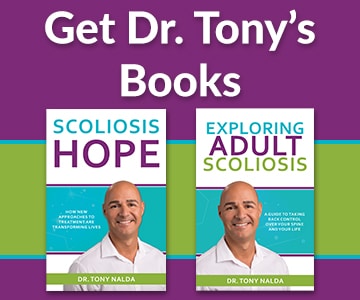 Ready to explore scoliosis treatment? Contact Us Now
Ready to explore scoliosis treatment? Contact Us Now